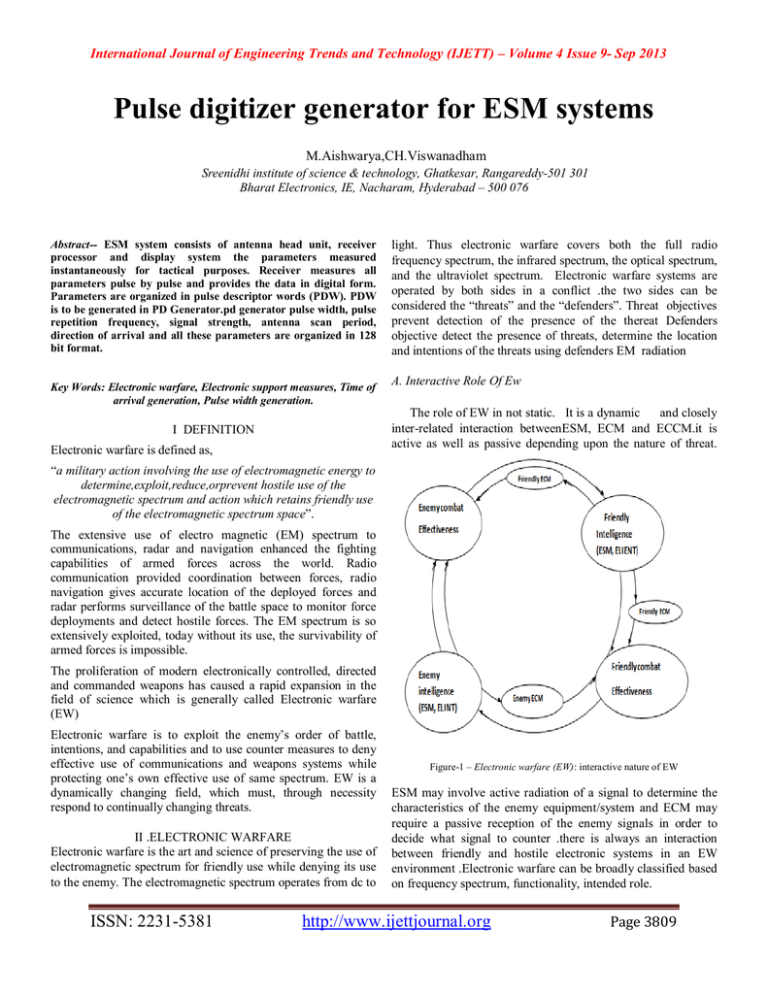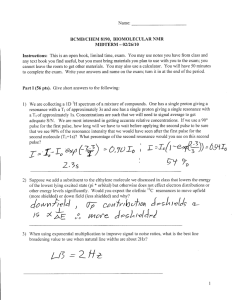Pulse digitizer generator for ESM systems
advertisement

International Journal of Engineering Trends and Technology (IJETT) – Volume 4 Issue 9- Sep 2013 Pulse digitizer generator for ESM systems M.Aishwarya,CH.Viswanadham Sreenidhi institute of science & technology, Ghatkesar, Rangareddy-501 301 Bharat Electronics, IE, Nacharam, Hyderabad – 500 076 Abstract-- ESM system consists of antenna head unit, receiver processor and display system the parameters measured instantaneously for tactical purposes. Receiver measures all parameters pulse by pulse and provides the data in digital form. Parameters are organized in pulse descriptor words (PDW). PDW is to be generated in PD Generator.pd generator pulse width, pulse repetition frequency, signal strength, antenna scan period, direction of arrival and all these parameters are organized in 128 bit format. Key Words: Electronic warfare, Electronic support measures, Time of arrival generation, Pulse width generation. light. Thus electronic warfare covers both the full radio frequency spectrum, the infrared spectrum, the optical spectrum, and the ultraviolet spectrum. Electronic warfare systems are operated by both sides in a conflict .the two sides can be considered the “threats” and the “defenders”. Threat objectives prevent detection of the presence of the thereat Defenders objective detect the presence of threats, determine the location and intentions of the threats using defenders EM radiation A. Interactive Role Of Ew The role of EW in not static. It is a dynamic and closely inter-related interaction betweenESM, ECM and ECCM.it is active as well as passive depending upon the nature of threat. I DEFINITION Electronic warfare is defined as, “a military action involving the use of electromagnetic energy to determine,exploit,reduce,orprevent hostile use of the electromagnetic spectrum and action which retains friendly use of the electromagnetic spectrum space”. The extensive use of electro magnetic (EM) spectrum to communications, radar and navigation enhanced the fighting capabilities of armed forces across the world. Radio communication provided coordination between forces, radio navigation gives accurate location of the deployed forces and radar performs surveillance of the battle space to monitor force deployments and detect hostile forces. The EM spectrum is so extensively exploited, today without its use, the survivability of armed forces is impossible. The proliferation of modern electronically controlled, directed and commanded weapons has caused a rapid expansion in the field of science which is generally called Electronic warfare (EW) Electronic warfare is to exploit the enemy’s order of battle, intentions, and capabilities and to use counter measures to deny effective use of communications and weapons systems while protecting one’s own effective use of same spectrum. EW is a dynamically changing field, which must, through necessity respond to continually changing threats. II .ELECTRONIC WARFARE Electronic warfare is the art and science of preserving the use of electromagnetic spectrum for friendly use while denying its use to the enemy. The electromagnetic spectrum operates from dc to ISSN: 2231-5381 Figure-1 – Electronic warfare (EW): interactive nature of EW ESM may involve active radiation of a signal to determine the characteristics of the enemy equipment/system and ECM may require a passive reception of the enemy signals in order to decide what signal to counter .there is always an interaction between friendly and hostile electronic systems in an EW environment .Electronic warfare can be broadly classified based on frequency spectrum, functionality, intended role. http://www.ijettjournal.org Page 3809 International Journal of Engineering Trends and Technology (IJETT) – Volume 4 Issue 9- Sep 2013 B. Frequency Spectrum Classification Electronic warfare is divided into four groups based on frequency as communicationEW, RadarEW, Electroopical/infrared EW, Hybrid electro optical/infrared-RF EW. 1) Communication Ew: Communication links are required to transmit and receive voice, digital data, FAX, etc.between land forces, aircrafts and ships. They may use HF (3-30) VHF (30300 MHz) and UHF (300 MHz-3GH).communication link data rates depend on link bandwidth, modulation technique and signal to noise to noise ratio. Advances in computer technology have enabled increased communication link capacity for handling and processingdata.the high data rates permit transmission from satellites and between precision weapons and launch platforms. Communications EW involves interception, direction finding and analysis of hostile emissions, whether voice or data link. Analysis of intercepted signal provides valuable information for command and control purposes. The real time data is necessary to counter the enemy’s communication system by jamming. 2) RADAR EW: Armed forces use radar in both defensive and offensive weapon systems. Reflected RF echoes of the target are used to measures target range. Bearing and elevation and determine target location. Radar uses rf transmission ranging from high frequency (HF) to millimeter waves (30mhz95ghz).the frequencies are designed by various alphabetical letters .both old and new designations are given at table.rf can be pulsed or continuous wave(cw). Radar function includes target detection, acqusion, tracking and navigation. radar extract range,bearing and speed of a target. radar information’s used for launch and control of a weapons like missle,air defense gun,etc.modern advancements include phase array anteena,complex modulation on the radar, low probability of intercept radar, improved signal processing to extract data from highly corrupted echo signal,etc. Radar EW involves extraction of detailed information of radar signals emmited, use of this information either to formulate electronic order of battle (EOB) or provide the information to a jammer to operate in an efficient way. 3) Electro-Optic/Infrared (Eo/If) Ew: There has been a steady growth in EO/IF guided weapons’ spectrum extends beyond millimeter waves. the IR encompasses wave length from 1000(300ghz) to 1 micron. in general hot targets like jet engines emit ir energy in the 0.75 u to 3 u range.EW systems and threats receivers use IR energy to detect, identify, locate and guide missiles to radiating objects’ guided missile detects the IR signature of the aircraft and home on to the emitter of the IR energy.Theplume, the tail pipe, heated leading edges of wings, or the IR image of the aircraft itself can be source of IR for locking on of the missile using an IR seeker. EW involves the detection and location of an incoming missile warning recevier and deflection of the same by launching chaff, etc. 4) Hybrid Ir/Eo-Rf: Present trend is to develop a hybrid recevier which fuzes the data obtained from radar,IR/EO Sensors,ESM sensors etc.to obtain more accurate more accurate identification and location of a missile emmiter.these hybrids provide a high resolution three-dimensional target information that greatly improves EW response. III FUNCTIONALITY CLASSIFICATIONS EW is classified based on functionality into three groups electronic support (ES) electronic attack (EA), electronic self protection (EP), these are the new names given to Electromagneticsupportmeasures (ESM), Electromagnetic counter measures (ECM), Electromagnetic countercountermeasures (ECCM). A. Electronic Support Measures (Esm) ESM is ”that division of electronic warfare involving actions taken to search for, intercept, locate, record, and analyze radiated electromagnetic energy for the purpose of exploiting such radiations in the support of military operations”. ESM is the receiving part of EW.EW received generally measures quantitatively the following parameters frequency,amplitude(power),angle of arrival(AOA)time of arrival(TOA),pulsewidth(PA).pulse repetition time(PRT),PRI type, scan type and rate, lobe duration(beam width 1) FREQUENCY: The period occurrences of a repeating event per unit time. The period is the duration of one cycle in a repeating event so the period is the reciprocal of the frequency The period is usually denoted by T, the length of time taken by one cycle, and is the reciprocal of the frequency. T=1/f Figure2-Radar Electronic warfare (EW): Radar frequency designations ISSN: 2231-5381 http://www.ijettjournal.org Page 3810 International Journal of Engineering Trends and Technology (IJETT) – Volume 4 Issue 9- Sep 2013 2) AMPLITUDE: The amplitude of a periodic variable is a measure of its change over a single period Figure-5 – Electronic support measures (ESW): pulse width. 5) Pulse Repetition Frequency: Pulse repetition frequency is the number of pulses per time unit. It is measured in hertz. Pulse repetition frequency has a pulse period, T which is time between pulses Figure-3– Electronic support measures (ESW): amplitude. T=1\PRF 3) ANGLE OF ARRIVAL: Angle of arrival measurement is a method for determing the direction of propagation of a radio frequency wave incident on an antenna array Pulse repletion frequency is required for a radar operation. This is the rate at which transmitter pulses are sent into space Figure-6 – Electronic support measures (ESW): pulse repetition frequency Figure-4 – Electronic support measures (ESW): angle of arrival 6) Time Of Arrival: Time of arrival is the travel time of a radio signal from a transmitter to a receiver. 4) Pulse Width: It is the time interval between the leading edge and trailing edge of a pulse at a point where theamplitudeis50%ofthepeak. 7) Beam Width: In telecommunication, the term beam width’s a radio antenna pattern, the half power angle between the half power (-3db) point of the main lobe. Beam width is usually expressed in degrees and for the horizontal plane. ISSN: 2231-5381 http://www.ijettjournal.org Page 3811 International Journal of Engineering Trends and Technology (IJETT) – Volume 4 Issue 9- Sep 2013 IV. PULSE DIGITIZER A. General Description The main functions of pulse digitizer are (a) Generation of PDW data. (b)Generation of TOA data. (c)Generation of timing signals for PDW and TOA data. B. Functional Description Figure-7 – Electronic support measures (ESW): beam width B. Electonic Counter Measures (Ecm) ECM is “that division of electronic warfare involving actions taken to prevent or reduce an enemy‘s effective use of electromagnetic spectrum” .ECM itself consists of two types .the first is jamming and the second deception. ECM is used to jamming, chaff and flares to interference with the operation of radars, military communication, and heat-seeking weapons. C. Electronic counter-Counter Measures (Eccm) ECCM “is the division of electronic warfare involving actions taken to insure friendly effective use of the electromagnetic spectrum despite the enemy’s use of electronic warfare”.ECCM defined as measures taken in the design or operation of radars or communication systems to counter the effects of ECM. The main function of pulse digitizer is to receive the pulse parameters from the measurement sections and forms a PD word. This can be divided into four parts. (a) Generation of TOA bits from input pulse. (b) Generation of pulse width (PW) bits from input pulse. (c) Generation of timing signals like WAO, WA1 and PWSTB (d) Collection of all bits and format into PD word including parity bit. It will form pulse descriptor words of four and each word 32 bit. C. Timing Generation The generate timing signals using the ORTTL as the reference signal and clock as input signal. All the timing signals like EOPR, BUSY, TOASTB, PWSTB, PDpresence, WCLK, WA0, WA1 are generated D. Pulse Width Generation Pulse width is calculated using the counter logic. This counter will start counting with rising edge of ORTTL and stops with falling edge of ORTTL.EOPR is used to clear the counter and D-latches. Pulse width valid is generated using comparator logic. E. Time Of Arrival (Toa) Generation TOA of 36 bit generated using the clock of 20 MHZ as main input .each bit resolution of TOA is 100ns. PRF is calculated in ESM processor based on TOA (0-35). Electronic warfare F. PD Formation/Multiplexing ESM ECM ECCM Figure-8 – Electronic warfare (EW): Electronic warfare has classically been divided into ESM, ECM, and ECCM. ISSN: 2231-5381 32 bit pulse descriptor word format will be done in FPGA .totally four words will be latched to the ESM processor using multiplexer logic in .multiplexing will be done using two selection lines that are WA0.WA1.Multiplexing is used to reduce hardware from 128 lines to 32 lines. Frequency data first word will be latched using LESTB(leading edge strobe), TESTB(trailing edge strobe), and last bit of each word (32 bit) will be parity bit http://www.ijettjournal.org Page 3812 International Journal of Engineering Trends and Technology (IJETT) – Volume 4 Issue 9- Sep 2013 ORTTL CIK BIO DATA OF AUTHOR Timing Generator PW Timings ORTTL RFP PWGEN TOA Timings TOA GEN TOA (0-35) WADD&WCLK PW (0-13) PD DATA PD Formatter &parity Gen AMPLITUDE (0-7) WADD&WCLK BITE DF (0-8) FREQ &FLAGS M.Aishwarya had completed of B Tech (ECE) from j Jawaharlal Nehru technological university Hyderabad, Andhra Pradesh, India. She is pursuing his Master’s degree in Digital systems and computer Electronics from Sreenidhi institute of science and technology Ranga reddy Andhra Pradesh. India. DFA BIO DATA OF AUTHOR (S) Block Diagram of Pulse Digitizer Figure-9–Pulse Digitizer(PD):Block diagram of pulse digitizer. 1) Pulse Descriptor Format : It is a 128 bit word format digitized values of frequency, amplitude, direction of arrival, time of arrival and flags. Time of arrival helps in determining pulse repetition interval from two pulse descriptive word Ch Viswanadham joined Bharat Electronics as Deputy Engineer in 1990 after completion of B Tech (ECE) from Nagarjuna University, Guntur, Andhra Pradesh. He has rich experience in Design, Production, Testing, Integration & commissioning of ESM systems on different types of Naval platforms. He was instrumental in configuring in-house ESM for Naval platform and had won R&D award from BEL. He has also pursued his Master’s degree in Digital systems from Osmania University during work at BEL. He joined IETE recently as FELLOW. Presently he is working as Deputy General Manager in D&E division at BEL, Hyderabad Figure-10 – Pulse digitizer (PD): pulse descriptor format. REFERENCES [1] Schleher, “Introduction to Electronic Warfare,” [2] Byron Edde, “Radar principles, Technology, Applications.” [3] Richard A Poisel, “Introduction to communication EW Systems,” [4] Skolnkin, “Introduction to Radar systems” [5] Sergei A Vakin, “Fundamentals of EW” [6] Filllippo neri, “introduction to electronic defense systems” [7] Kolawole, “Radar systems,peak detection &tracking” ISSN: 2231-5381 http://www.ijettjournal.org Page 3813






